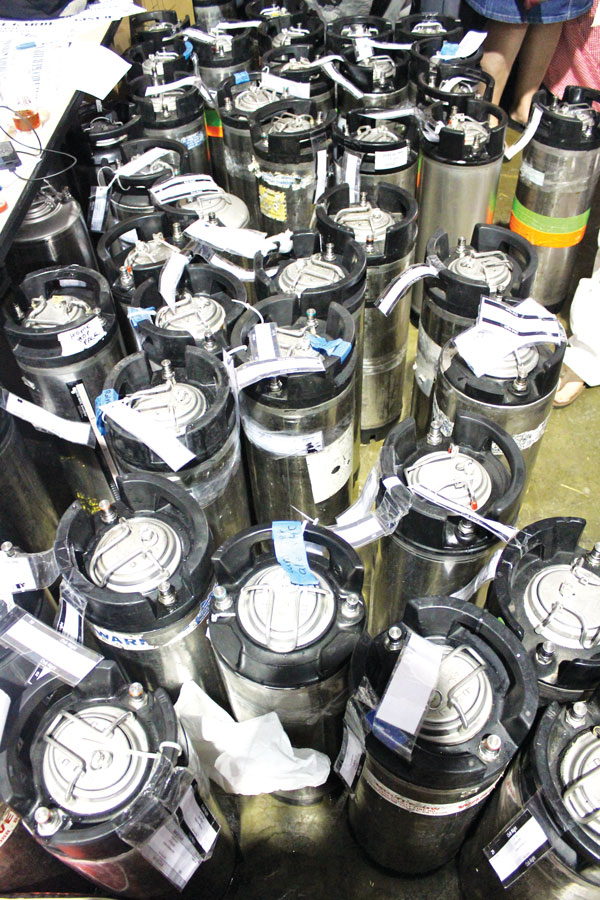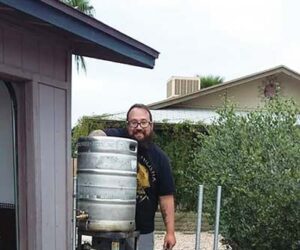Making Your Homebrew Club Engaging
The King of Clubs
Brewers are a weird lot. We’re engaged in a hobby that involves hours of solitary fussing around with boiling and fermenting liquids. Scrubbing, carbonating, making like a frantic hermit to prepare what has historically been a social beverage. We won’t lie — the two of us are both introverts that like the comforts of our favorite comfy home chair, but beer is meant to be shared and that’s why homebrew clubs are a fundamental part of this sometimes anti-social hobby. Unfortunately, clubs need our help . . .
The Challenges Facing Clubs

In the early days of the COVID-19 pandemic, when regular folks embraced the sourdough life, there was a strong surge in the homebrewing world. A combination of time, isolation, and an inability to wander over to the brewery for beer led to a lot of kettles being fired up. But the post-pandemic picture has become bleak. Money is tight, people have shifted to drinking spirits (or are abstaining from drinking), and the excitement and buzz that surrounded brewing has receded.
A perfect example — despite being held in San Diego, California, one of the beer world’s powerhouse playgrounds, the American Homebrewers Association’s Homebrew Con fell short of their attendance goals. Where in pre-COVID times, the last San Diego conference attracted over 3,500 attendees, this year’s repeat engagement drew less than 2,000. No matter how you slice it, that’s a major decline.
The same shortfall is being felt by our local homebrew shops. Every day we wake up to news that even the big retailers are feeling the pinch. (In other words – go buy your ingredients from a shop not from Amazon!)
And as goes things rolling down the proverbial gravity well, clubs are impacted as well. Taking time out of your busy weekend (or a weeknight like many clubs) can feel like a bridge too far. Drive how far? At what time? Drive home after drinking beers? No thank you — can’t this just be an email, or better yet a text?
Why Clubs Matter
With the rise of the internet, Zoom calls, remote work, and talking with people from around the world — Drew’s daily life for instance — one can very easily wonder, “why go to a club meeting?”
Internet-only clubs are nothing new. Even before The Brewing Network’s “BN Army,” homebrew club of listeners began giving national competitions the fits (Zut alors! Hue and cry galore!), online forums like the late Home Brew Digest or Rec.Crafts.Brewing provided a collegial club-like atmosphere. (If you remember either of those, please schedule a checkup and oil change with your doctor.)
But for all the vaunted ability of the internet to connect us to our fellow obsessives, no one has managed to implement a proper internet protocol for the delivery of draft beer over IP — yet. And ultimately, despite all the time spent puttering, you can’t beat sharing your beer with people who aren’t just in it for the free beer. Let’s get serious, your neighbor Ed probably thinks Mosaic® and Galaxy® are names of new fishing lures and would drink your beer even if it tasted remotely good.
In the best of worlds, a club serves to bring together like-minded hobbyists to explore their shared craft . . .
In the best of worlds, a club serves to bring together like-minded hobbyists to explore their shared craft — sharing education, experience, and providing enthusiasm to all involved. In the worst, it becomes a closed-off cesspool of in-jokes, standoffishness, or worse, pushy “know-it-all-ism.” We’re here today to make sure your club is solidly in the former and not the latter description.
The Bare Minimum Code of Running a Successful Club
Hold your events in public: Hosting meetings at someone’s home can not only be a draining experience for the host, but it’s intimidating for most people to intrude on someone’s homestead. There are obvious exceptions to this, like with smaller homebrew clubs, but it’s a good rule.
Work with your local homebrew shop or a beer bar/brewery. Post signs, messages, etc., that the event is happening and make sure your hosts are OK with homebrew being poured. Being in public can also bring in new accidental members who stumble on your get-together.
Mind the new folks: Most new brewers are likely to be intimated by meeting with a well-established group of people. (If they’re not, recruit them to be officers immediately!) Name tags are utterly dorky but can help. Appoint your social butterflies to act as club greeters to engage with new attendees.
Get folks active: It’s easy for people to feel detached and leave a club if they’re an uninvolved passive member. Find small projects, efforts (“hey, can you help pour beer?”) to get them engaged. Find the skills of your people and ruthlessly (within reason) use them! This is especially true if you’re terrible at social media — a vital avenue of promoting your club.
Stay focused and loose (holy contradictions, Duff Man!): You’re there for the beer! Keep things focused on that subject. Keep things fun. Taking something fun too seriously is the surest way to kill people’s interest. And yes, that means not every conversation needs to be about how someone didn’t follow the perfect technique for making a beer. Remember your Sesame Street and Mister Rogers messaging: Kindness matters!
If that’s too much or too organized for you, stick to the first principle — we’re all here to enjoy learning the art of making beer. It’s a non-serious, serious pursuit meant to be treated with all the frothy, friendly joy of a warm summer day sitting lakeside. Beer doesn’t want to be taken seriously. It wants to be shared, talked over, laughed over, and laughed about.
Making Your Club Great
The first trick for making a great club is to figure out what the members want. Are they interested in learning styles? Quietly engaging with brewing esoterica and the minutia of their sample? Trying to brew the most medaled beer in competition history? Heartily washing down the dust of a tedious week while comparing notes?
If you try and frog march a bunch of people dedicated to exploring how they’ve seized the means of beer production into the arena of competition, you’ll end up with disappointing results and disaffected members. The same result if you try and force a bunch of metal heads to treat every brew day like a Jimmy Buffett tailgate.
Remember, people’s time and energy are precious, and patience can run short if they are not engaging in a manner that is enticing. You must figure out how to balance what they want and what they need. This should be a regular part of a club meeting’s discussion.
What to Do with Your Club
Establish a schedule — Stick to it and shout it out! Nothing kills people’s involvement faster than not knowing when things are happening. It’s best to stick to a schedule (1st Sunday of the month at 11 a.m. for Drew’s Maltose Falcons and last Monday at 7 p.m. for Denny’s Cascade Brewers Society).
Don’t assume everyone knows or remembers — put the word out there, repeatedly and often. Having a dedicated Social Media Coordinator comes in handy. If you deviate from the schedule — hammer on the communication to get it to stick!
Create a mix of events: For the Falcons we run two competitions, three festival/campouts, nine meetings, 11 happy hours, four yearly club-only competitions, a holiday tasting, a mead tasting, a variable number of brew sessions at our sponsoring homebrew shop, and we dedicate the month of March to brew sessions at member’s homes on their systems.
The Cascade Brewers Society keeps things a little lighter with meetings every month with a technical presentation, five club-only competitions, brew days for Learn to Brew and Big Brew, and a campout.
And that’s just our two clubs. There are tons of options — coordinate experiments, have a speaker from a local brewery (or hire Denny & Drew impersonators for $20 or the real thing for free), make people brew with funny ingredients, hold a yard sale, rent a bus and take the show on the road, raise money for charity, make artisanal free-range pretzel necklaces for your next party.
Put equal strain on all parts (aka farm out the work): Even running a barebone set of events, like meetings, is a lot of work for an individual. Spread the work, spread the love, and spread the involvement! (This has the side effect of increasing engagement as well.)
Make sure to plan: You could trust our word, but it’s much better to take it from an expert in making big social efforts pay off — namely the Falcons’ Treasurer and Planner of Things, like the 50th Anniversary Party, Tiffany Ashrafi. Here is her top advice for other homebrew club coordinators:
Don’t procrastinate. For example, when planning a brewery tour for the club: Contact the breweries as soon as possible to nail down a date that works for all. This way advertising for the event can be posted quickly to spread the word and start selling passes. Breweries appreciate it when you can give them an updated headcount a few days prior to arrival.
Be persistent. There is no shame in persistence mixed with patience. If I don’t hear back from a brewery, potential sponsor, or fellow club member about an inquiry right away, I’ll wait a day or so then find another avenue to contact them. Sometimes Instagram direct message is checked more often than Facebook messenger or texts. But don’t give up after the first point of contact.
Do your research & shop around. I try to get the best price for attendees so as many of our members can join the fun as possible. But I also want to stay within budget, so the Board Treasurer doesn’t get upset (the treasurer is me . . .).
Ask. Ask club members for their opinions and consider all suggestions. The events I plan are for club members, after all. Work as a team to create something everyone will remember for a long time and say, “Hey, that was my idea!” Ask for help! Planning anything requires many hands and minds to make it a successful event.
“Great! You’ve given us a ton of planning and engagement advice, but what do we do?”
The Practical List of Club Activities
Brewing Activities
Club brews — There is no better way to practice homebrewing than to brew with each other. Whether at home or some common location, make this a habit. Incorporate a challenge, a theme, share recipes, talk and be silly — heck, why not fill a barrel while you’re at it.
Collaboration brews — Make a beer with a local brewery. Put the club’s name on the beer. It’s great to see what’s different when you’re not on your stove or in your garage. Even better, take some wort home and compare the batches.
Ingredient shares — Get a bunch of malt from a craft maltster or even fruit or honey from a local farmer. Everyone gets to showcase what they can do when given something unique.
Wort share — Like the collaboration brew, mash an over-sized batch of wort at one time and split the resulting liquor amongst multiple brewers and let them choose their own fate with it.
Competition Activities
Pre-judging — Have members bring their beers for evaluation and judging before they compete. Help them improve before they spend their money.
Planning — For those regions with regular competition circuits, coordinate as a group. Figure out how your club will beat the competition.
Packaging help — Have a day dedicated to packaging beer for competition. Meet up to bulk ship entries to save money and ensure your beers arrive intact.
Run a competition leaderboard —
Keep track with points awarded for medals won in different competitions.
Educational Activities
Host a technical seminar — Denny’s club does this during meetings. Walk people through new gear, new techniques, and new ingredients. Teach people the fundamentals of malt, water, yeast, and hops; there are so many potential lessons right there.
Walk people through a beer style — Drew does this for the Falcons. Buy a mix of 4–5 different versions of a style of beer and walk through each with notes and discuss what makes the style unique. Go through, past, and beyond the BJCP (Beer Judge Certification Program) guidelines.
Sensory kit education — Torture your club members with an off-flavor sensory kit from Siebel or BJCP. Doctor cheap beer and get them to smell/taste different compounds and walk through what causes them in actual brewing.
Frolicking Activities
Bus/train/transit brewery trip — Gather a bunch of your friends and hit the trails to stop at a handful of breweries. Work out a deal with them ahead of time and keep people rolling on.
Happy hours — Since COVID-19 hit, Drew’s been doing these with the Maltose Falcons — now monthly. Buy mixed four packs from a local brewery and have everyone hop online with the brewer to taste and talk through the beers. This may get more participation than just driving to the brewery.


